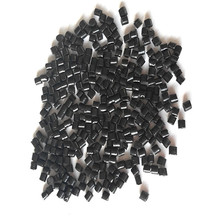Webb telescope discovers 6 rogue worlds. They didn't form the way you'd expect.
Sometimes, planets go rogue.
Scientists used the powerful James Webb Space Telescope to spot six of these rogue objects, which move through the cosmos untethered from any solar system. They're a little bigger than the gas giant Jupiter, and the discovery suggests these worlds formed similar to the way stars form — rather than how planets are usually created.
Astronomers have waited for years to harness the abilities of the Webb telescope, whose large mirror gathers bounties of distant, faint light, to find such free-floating objects.
"It has been in planning for a decade," Ray Jayawardhana, an astronomer at Johns Hopkins University and senior author of the study, told Mashable.

 SEE ALSO:NASA scientist viewed first Voyager images. What he saw gave him chills.
SEE ALSO:NASA scientist viewed first Voyager images. What he saw gave him chills.You can see three of these rogue planets below, circled in green. They're located about 1,000 light-years away in our galaxy, inhabiting the nebula NGC1333, an enormous region of dust and gas where stars form.
"It has been in planning for a decade."
Although it's possible they originally formed as planets around a star, the researchers think they're more likely failed stars — but didn't have nearly the mass needed to ignite a stellar engine like our sun. (Stars form when enormous clouds of gas collapse and heat up, ultimately creating the immense pressure and heat needed for star creation.) The lowest-mass object found, about five times the mass of Jupiter, shows evidence of a dusty disk around it, and space dust often spins around a central object amid star formation. What's more, it's hard to imagine a planet getting ejected from its solar system and maintaining such a disk.
"The objects more likely formed how stars formed," Rayawardhana said.
The research has been accepted for publication in The Astronomical Journal, a peer-reviewed science chronicle.
 The green circles show three of the recently observed rogue planets in the nebula NGC1333.Credit: European Space Agency
The green circles show three of the recently observed rogue planets in the nebula NGC1333.Credit: European Space AgencyThe rogue objects are similar in mass to other large gaseous planets found beyond our solar system, called exoplanets. If they aren't failed stars, these objects would have needed to get thrown out of their solar system, perhaps by a close gravitational interaction with another planet, or a second star (most solar systems have two or more stars).
The investigation of rogue objects continues. The astronomers have been awarded more competitive time with the Webb telescope to peer at such objects with dusty disks. Could they be "mini-planetary" systems like the many curious moons orbiting Saturn and Jupiter? As we know in our own solar system, these planetary systems include intriguing moons, some of which harbor oceans beneath their icy shells.
A bonus sighting: Although not a part of this research endeavor, the Webb image above shows telltale evidence of a newly forming solar system. Look near the bottom right, below the black bar, where you can see two dark cone-like features emanating from a bright central spot. That's Webb, from our perch in the Milky Way galaxy, viewing the dusty disk of the solar system side-on, as we might view the side of a frisbee. The nascent system's dust-filled disk blocks starlight, creating those two dark flares.
Featured Video For You
10 mind-blowing discoveries from the James Webb Telescope
The Webb telescope's powerful abilities
The Webb telescope — a scientific collaboration between NASA, ESA, and the Canadian Space Agency — is designed to peer into the deepest cosmos and reveal new insights about the early universe. But it's also peering at intriguing planets in our galaxy, along with the planets and moons in our solar system.
Here's how Webb is achieving unparalleled feats, and likely will for decades to come:
Related Stories
- Our galaxy might crash into Andromeda. What would happen to us?
- NASA spacecraft spots dead robot on Mars surface
- The best telescopes for gazing at stars and solar eclipses in 2024
- Webb telescope makes unexpected find in outskirts of our solar system
- If a scary asteroid will actually strike Earth, here's how you'll know
- Giant mirror: Webb's mirror, which captures light, is over 21 feet across. That's over two-and-a-half times larger than the Hubble Space Telescope's mirror. Capturing more light allows Webb to see more distant, ancient objects. As described above, the telescope is peering at stars and galaxies that formed over 13 billion years ago, just a few hundred million years after the Big Bang. "We're going to see the very first stars and galaxies that ever formed," Jean Creighton, an astronomer and the director of the Manfred Olson Planetarium at the University of Wisconsin–Milwaukee, told Mashable in 2021.
- Infrared view: Unlike Hubble, which largely views light that's visible to us, Webb is primarily an infrared telescope, meaning it views light in the infrared spectrum. This allows us to see far more of the universe. Infrared has longer wavelengths than visible light, so the light waves more efficiently slip through cosmic clouds; the light doesn't as often collide with and get scattered by these densely packed particles. Ultimately, Webb's infrared eyesight can penetrate places Hubble can't.
"It lifts the veil," said Creighton.
- Peering into distant exoplanets: The Webb telescope carries specialized equipment called spectrographsthat will revolutionize our understanding of these far-off worlds. The instruments can decipher what molecules (such as water, carbon dioxide, and methane) exist in the atmospheres of distant exoplanets — be they gas giants or smaller rocky worlds. Webb looks at exoplanets in the Milky Way galaxy. Who knows what we'll find?
"We might learn things we never thought about," Mercedes López-Morales, an exoplanet researcher and astrophysicist at the Center for Astrophysics-Harvard & Smithsonian, told Mashable in 2021.
Already, astronomers have successfully found intriguing chemical reactions on a planet 700 light-years away, and have started looking at one of the most anticipated places in the cosmos: the rocky, Earth-sized planets of the TRAPPIST solar system.
(责任编辑:关于我们)
-
Washington Mystics vs. Chicago Sky 2024 livestream: Watch live WNBA
 TL;DR:Watch Washington Mystics vs. Chicago Sky in the WNBA with WNBA League Pass. Avoid blackouts an
...[详细]
TL;DR:Watch Washington Mystics vs. Chicago Sky in the WNBA with WNBA League Pass. Avoid blackouts an
...[详细]
-
 开车的师傅注意了,从4月1日起,酒后驾车将被一次性扣罚12分。按照公安部新修订的《机动车驾驶证申领和使用规定》,从4月1日起,凡100毫升血液中酒精含量大于等于20毫克的驾驶员将被认定为饮酒后驾车,将
...[详细]
开车的师傅注意了,从4月1日起,酒后驾车将被一次性扣罚12分。按照公安部新修订的《机动车驾驶证申领和使用规定》,从4月1日起,凡100毫升血液中酒精含量大于等于20毫克的驾驶员将被认定为饮酒后驾车,将
...[详细]
-
 雅安日报讯 “设立乡镇人大专职主席,设立街道人大工作委员会,加大基层人大工作经费保障力度……”这是雨城区贯彻落实党的十七大和十七届四中全会及省、市、区委人大工作会议精神的具体行动。1月下旬,雨城区人大
...[详细]
雅安日报讯 “设立乡镇人大专职主席,设立街道人大工作委员会,加大基层人大工作经费保障力度……”这是雨城区贯彻落实党的十七大和十七届四中全会及省、市、区委人大工作会议精神的具体行动。1月下旬,雨城区人大
...[详细]
-
 本报讯“巍巍二郎山作证,滔滔青衣江作证。”“作证……证……证……”昨2)日,在天全县烈士陵园举行的“魂归二郎山”公祭活动上,两名小学生朗诵诗《作证——为修建川康公路牺牲的解放军战士而作》时,“作证”在
...[详细]
本报讯“巍巍二郎山作证,滔滔青衣江作证。”“作证……证……证……”昨2)日,在天全县烈士陵园举行的“魂归二郎山”公祭活动上,两名小学生朗诵诗《作证——为修建川康公路牺牲的解放军战士而作》时,“作证”在
...[详细]
-
 China's Tsinghua University has scored a world first by demonstrating the inherent safety of the fir
...[详细]
China's Tsinghua University has scored a world first by demonstrating the inherent safety of the fir
...[详细]
-
 登山比赛现场“各就各位……预备,跑!”4月29日上午,随着裁判员一声发令枪响,近百名运动员冲出起点,向着宏伟的西蜀天梯奔去。市直属机关第四届职工运动会登山比赛隆重举行,共有47个单位代表队的188名运
...[详细]
登山比赛现场“各就各位……预备,跑!”4月29日上午,随着裁判员一声发令枪响,近百名运动员冲出起点,向着宏伟的西蜀天梯奔去。市直属机关第四届职工运动会登山比赛隆重举行,共有47个单位代表队的188名运
...[详细]
-
 雅安日报讯 大旱无情,我们有爱。2日,雨城区大兴中心小学全校师生在校园内举行了“抗旱救灾爱心在行动”捐款仪式,以实际行动支援抗旱救灾。捐款仪式上,学校负责人作了抗旱救灾捐款动员讲话:2009年秋季以来
...[详细]
雅安日报讯 大旱无情,我们有爱。2日,雨城区大兴中心小学全校师生在校园内举行了“抗旱救灾爱心在行动”捐款仪式,以实际行动支援抗旱救灾。捐款仪式上,学校负责人作了抗旱救灾捐款动员讲话:2009年秋季以来
...[详细]
-
 家人陪护老人逛街“和身体疾病相比,心理健康问题更隐蔽,一则不易发现,二则极易忽视,正是这些‘心病’,将许多老人一步步逼上绝路。”4月19日,市精神卫生中心副院长邹开庆告诉记者,老年人从轻微的心理疾病发
...[详细]
家人陪护老人逛街“和身体疾病相比,心理健康问题更隐蔽,一则不易发现,二则极易忽视,正是这些‘心病’,将许多老人一步步逼上绝路。”4月19日,市精神卫生中心副院长邹开庆告诉记者,老年人从轻微的心理疾病发
...[详细]
-
 “大体老师”是解剖医生对遗体捐献者的尊称。称为老师,意为捐献者用自己的身体为医学、科学作出了贡献。红十字会在人体器官捐献工作中的职责主要包括开展人体器官捐献的宣传动员、意愿登记、捐献见证、缅怀纪念、人
...[详细]
“大体老师”是解剖医生对遗体捐献者的尊称。称为老师,意为捐献者用自己的身体为医学、科学作出了贡献。红十字会在人体器官捐献工作中的职责主要包括开展人体器官捐献的宣传动员、意愿登记、捐献见证、缅怀纪念、人
...[详细]
-
 雅安日报讯 昨19)日,雨城区组织全区干部职工和16家爱心企业,向玉树灾区进行募捐,在短短半个小时内,就募到现金38万余元。灾难无情,人间有爱。玉树强震后,雨城区第一时间作出反应,紧急支援灾区,第二人
...[详细]
雅安日报讯 昨19)日,雨城区组织全区干部职工和16家爱心企业,向玉树灾区进行募捐,在短短半个小时内,就募到现金38万余元。灾难无情,人间有爱。玉树强震后,雨城区第一时间作出反应,紧急支援灾区,第二人
...[详细]

 荥经县召开县委学习中心组第一次学习会
荥经县召开县委学习中心组第一次学习会 观望情绪蔓延 波及县域房地产市场
观望情绪蔓延 波及县域房地产市场 “倒春寒”来袭我市两条国道挺住了
“倒春寒”来袭我市两条国道挺住了
